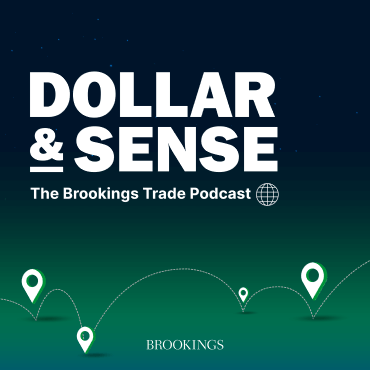A global shortage of semiconductors has created serious anxiety in some industries and even caused automakers to halt production in several factories across North America. What led to this shortage, and is there anything manufacturers or the Biden administration can do to meet demand? David Dollar is joined by Don Clark, a contributor to The New York Times, to discuss the factors that triggered the recent supply issues and the potential implications for the future of chip manufacturing in the United States.
Related content:
‘It’s a Roller-Coaster Ride’: Global Chip Shortage Is Making Industries Sweat
Intel to Spend $20 Billion on 2 New Chip Factories in Arizona.
Lagging but motivated: The state of China’s semiconductor industry
This transcript has been lightly edited.
DAVID DOLLAR: Hi, I’m David Dollar, host of the Brookings trade podcast Dollar and Sense. Today, we are talking about the semiconductor shortage which has caught the world off guard and is disrupting the auto industry and other sectors of the economy. My guest is Don Clark, a contributor to The New York Times on technology issues. Welcome to the show, Don.
DON CLARK: Hello there.
DOLLAR: So let’s start with the big picture. How serious is the semiconductor shortage for the economy now that we are recovering from the pandemic recession? What are the sectors that are particularly hurt by this?
CLARK: Well, I think the reason we are here talking today is because of the impact on the auto industry, which is a huge sector of the economy. They have been forced to temporarily close a bunch of plants in North America because of the chip shortage. So that has caused alarm bells in particular. Those are union jobs, the kind of people that voted for President Biden. This has definitely got the world’s attention, but there’s many other sectors of the economy that are affected. And not that the economy is doing that badly, but it’s kind of like we would be in a much better position had this not happened.
DOLLAR: I’ve read a number of your articles. You have some great stories about the types of firms that are affected far away from automobiles. You had one about a cement manufacturer. Does that ring a bell?
CLARK: This is a company that makes a little sensor that you place in places where you are going to pour concrete. So with these things that measure temperature in the ground, they beam signals to some people with laptops nearby and they can tell how quickly cement is hardening so that it’s secure. So these guys are worried about making future sensors. And they are worried not just about themselves, but on all the construction projects that they are involved with.
DOLLAR: So we’ve got chips just throughout the economy now. It’s really an interesting change. So how did we get to this shortage? What’s the failure here? We economists usually think about there being some kind of market failure to get you into a real mess. So, what was the failure here?
CLARK: Well, it’s really a combination of short-term and long-term factors both on the supply side and on the demand side. So the short-term factor, of course, is the pandemic. When the pandemic came around, people pulled in their sales or they just physically couldn’t keep production going. So the automakers in particular shut down temporarily. Meanwhile, everybody else, after sitting around at home, started buying everything you can imagine, particularly computers, appliances or game consoles, tablets, everything to educate and entertain themselves at home. So they started placing orders, and when the car guys came back around in the September time frame, they basically had lost their place in the manufacturing queue to get chip supplies. So they were disproportionately hurt. But there’s some other really interesting factors.
The chip industry has had many shortages before, but they usually are in a particular kind of chip like memory chips. This time it’s across the board, which is a sign that demand is really going through the roof. There’s two vectors. The chips are being used in many more kinds of products, and then each product that is using chips—like a car or a smartphone—they are using many more chips. So the cars that we are making today, they were designed three years ago. The cars next year are going to have even more chips. So it’s this kind of treadmill that wasn’t really factored in.
The other thing to keep in mind is that there’s both the new cutting-edge chips that are scarce supply—those mainly come from this one company, TSMC, in Taiwan, and that’s what’s in, say, the latest Apple smartphone—but also all these old factories, old chips, very simple things that were paid off years ago. In those cases, it’s very hard to upgrade those supply lines. The biggest factor is demand, but after that you get to these supply bottlenecks.
DOLLAR: Right. So to some extent, it sounds like the chip manufacturers didn’t anticipate this big surge in demand, which is kind of understandable because it’s been a really uncertain world.
CLARK: Yeah, and they have been expanding, but the great thing for a chip manufacturer is when their factory is full. They love that. When it’s empty, they lose lots of money. But if there’s a shortage and they can’t fill demand, they sort of leave money on the table. The history of the chip industry has been marked by these periods where they built too many factories so there’s a glut of chips or they built too few factories and there’s a shortage of chips. So they weren’t getting accurate demand signals from their customers. So a lot of the problem here is properly evaluating and forecasting demand, which is very difficult.
DOLLAR: Then I take it these firms cannot easily ramp up production. So the firms that suddenly have large increases in demand, can’t just—
CLARK: Yes, they cannot. There’s two dimensions of that. If they just wanted to build a new factory from scratch, the cutting-edge factories are $10 billion a pop, takes three years to build them. So that’s a long lag right there. Then you have these older factories I was talking about. Some of those are using a kind of smaller silicon wafer to make the chips, and the machines for making those kinds of chips aren’t being made anymore. So they can’t increase production even if they want to. So anyway, it’s not an easy situation.
The Brookings Institution is committed to quality, independence, and impact.
We are supported by a diverse array of funders. In line with our values and policies, each Brookings publication represents the sole views of its author(s).





Commentary
PodcastWhat’s behind the semiconductor shortage and how long could it last?
May 24, 2021
Listen on
Dollar and Sense Podcast